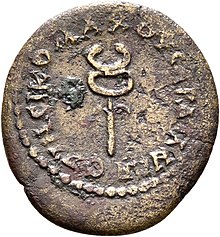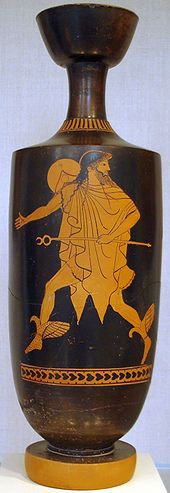Caduceus
![]()
Caduceus is a redirect to this article. For the game series of the same name, see Trauma Center.
The staff of Hermes (Gr.) or caduceus (Latin caduceus, Ancient Greek κηρύκειον kērýkeion, from κῆρυξ kēryx "herald"; also ῥάβδος rhabdos "staff") is a staff with two wings entwined by two serpents with their heads facing each other.
In antiquity, the herald's staff was the distinguishing mark of the heralds, which was supposed to signal the immunity of these bearers of military orders or secret messages and ensure their return without harm. In later times the herald's staff, as the staff of Mercury, was a symbol of trade, also in heraldry (Mercury's staff). The most famous staff bearer was the Greek god Hermes, who was called Mercurius (Mercury) by the Romans.
The design is interpreted in different ways: on the one hand as a combination of opposing forces (this interpretation was later used above all by the alchemists), on the other hand also as a symbol of fertility, whereby the staff was seen as a phallic symbol above which two snakes mate. In addition to Hermes/Mercury, the Greek messenger of the gods Iris and the Roman goddess of fortune Felicitas are also depicted with a heraldic staff.
In modern times, the staff of Hermes usually stands as a symbol for business and trade. The administrative services of German armies, police forces and shipping companies sometimes used the staff of Mercury as an additional emblem on their badges of rank; so did the customs administration of the GDR.
In the U.S., it is also used as a symbol of medical institutions, having been the trademark of a widely known 19th century medical publisher, and was adopted as the symbol of the U.S. Army Medical Corps in the early 20th century.
Coins of the Dutch Mint have carried a Mercury staff since 1830.
The Unicode symbol of the Hermes staff is U+2624 ☤ CADUCEUS.

US Army Medical Corps Badge

Coin from Sardis (ca. 140-144 AD). Reverse: Staff of Hermes

Hermes staff with two snakes
Genesis
According to Greek mythology, Hermes was born on the Kyllene Mountains in Arcadia as the son of Zeus and a nymph. On the very day of his birth he stole 50 cattle from his brother Apollo, who had to herd them in Thessaly on behalf of King Admetos. Dragged before Olympus by the raging Apollo, the amused Zeus ordered him to return the stolen cattle. Instead, Hermes beguiled Apollo with the playing of his self-invented lyre and persuaded him to take this lyre instead of the cattle. On top of that, he also received from Apollo a golden wand (= rhabdos chryseie) which sends sleep, even eternal sleep, and which can turn everything it touches into gold. His main attribute, besides the winged shoes and the broad-brimmed, shade-giving travelling hat (which is later also found with wings), is the herald's staff (Greek Doric κηρúκειον = kerykeion, in Homer also: kerykeion skeptron). In early times this staff is said to have been represented rather as a rod, consisting of an olive or laurel branch with two knotted tips.
On vase paintings and coins one usually finds a thin staff (rod) with a circle at the end and a half circle (or half moon) set above it. The same shape is also said to be found among Phoenicians and Hittites, possibly representing a combination of sun and crescent moon. In India, the symbol of the sun and crescent moon is said to have existed in still earlier times as the "Trishula". In alchemy and astrology, the staff of Hermes still stands for "Mercurius" (mercury) and the planet Mercury. One of the earliest representations in which two serpent heads are found on the staff of Hermes is a 5th century BC bronze caduceus in the National Museum of Palermo. Again, the caduceus is essentially a circle with a semicircle on the staff, except that the ends of the semicircle are depicted as snake heads. The earliest depiction of wings on the staff of Hermes is on a statue from the 1st century A.D. Wings and serpents are not regularly found on the caduceus until the 15th or 16th century.
Through contacts between Greek and Egyptian culture, at least since the conquest of Egypt by Alexander the Great, a link developed between the Greek Hermes and the Egyptian god Thot. Often depicted as a baboon or ibis, Thoth was considered the inventor of the calendar, writing, and the sciences, especially mathematics and astronomy, and was the god of laws, wisdom, magic, divination, and sacred books. He served as the scribe and recorder of the gods and recorded the judgment when the souls of the departed were weighed in the underworld against the pen of Truth Maat. Like Hermes, he was considered the transmitter of the decisions of the gods. The caduceus of Hermes had many meanings among the Greeks. Originally a magic wand, it was later considered predominantly a symbol of the herald and a symbol of peace. According to a legend, Hermes once found two snakes intertwined in a fierce battle. With an olive branch he separated the fighters, and in return they embraced the staff peacefully and turned to each other in love. Hermes with his symbol was henceforth regarded as a peacemaker. This is the most positive meaning that the staff of Hermes has acquired. Among the Romans, in addition to being a sign of peace, it was also considered a symbol of commerce and traffic. In Rome the merchants celebrated a festival in his honor on May 15. They sprinkled water on themselves in order to "cleanse themselves of the perjuries they had committed in their trade and dealings up to that point".

Hermes with winged shoes and staff, Attic lekythos, 5th century BC.
See also
- Heracles Knot
Search within the encyclopedia